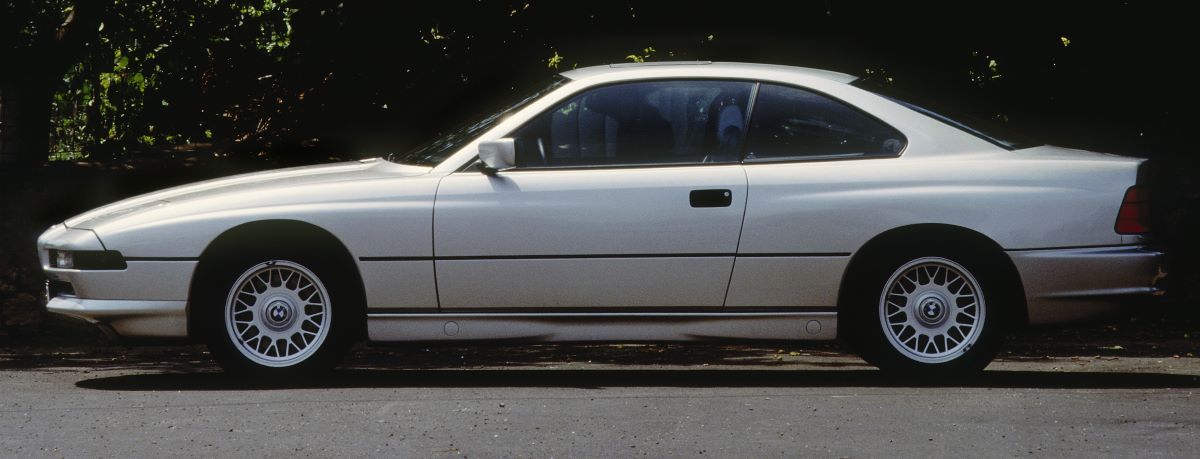
BMW 8 Series (1989-1999)
BMW presented a car of superlatives with the Gran Turismo Coupé 850i at the Frankfurt Motor Show in 1989. It remained in production until 1999, the models of the BMW 8 Series always ranked among the most exclusive automobiles in the world, combining elegance and dynamic performance in a unique way.

BMW 840Ci
A less expensive V8 version followed with the BMW 840Ci in 1993. The BMW 840Ci was supplied until production of the 8 Series came to an end in 1999. Around one third of all 8 Series customers opted for this model.
General Data
Model Year……………………………1993 – 1999
No. of Units…………………………..7,803
Price……………………………………DM 129,000
Technical Data
Type of Engine……………………….Eight-cylinder V-engine
capacity in ccm………………………3982
Power Output…………………………210 kW/286 bhp at 5800 rpm
Max.Speed (96 mph)…………………250 km/h (155 mph)
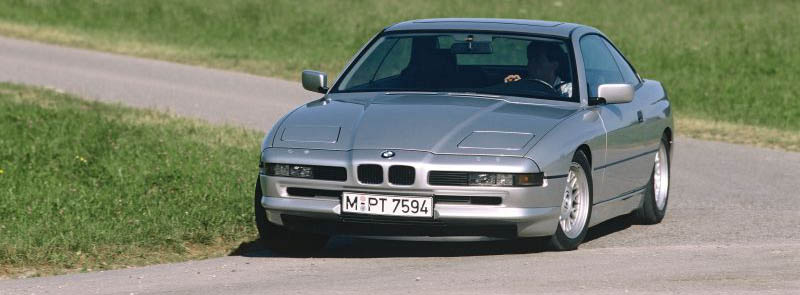
BMW 850i / 850Ci
The V12 engine used in the BMW 850i was itself a factor contributing to the exceptional status of a car that is predestined to become a classic. From autumn 1992 sold as BMW 850Ci.
General Data
Model Year……………………………1989 – 1994
No. of Units…………………………..20,072
Price……………………………………DM 135,000
Technical Data
Type of Engine……………………….Twelve-cylinder V-engine
capacity in ccm………………………4988
Power Output…………………………220 kW/300 bhp at 5200 rpm
Max.Speed…………………………….250 km/h (155 mph)
Dimensions……………………………4780x1855x1340
Empty Weight (kg)…………………..1790

BMW 850Ci
Marketing of the coupé was launched in autumn 1992 as the 850Ci and it was revised in 1994. The modified V12 engine generated a robust 327 hp with a displacement of 5.4 litres.
General Data
Model Year……………………………1994 – 1999
No. of Units…………………………..1,218
Price……………………………………DM 157,000
Technical Data
Type of Engine……………………….Twelve-cylinder V-engine
capacity in ccm………………………5379
Power Output…………………………240 kW/327 bhp at 5000 rpm
Max.Speed…………………………….250 km/h (155 mph)
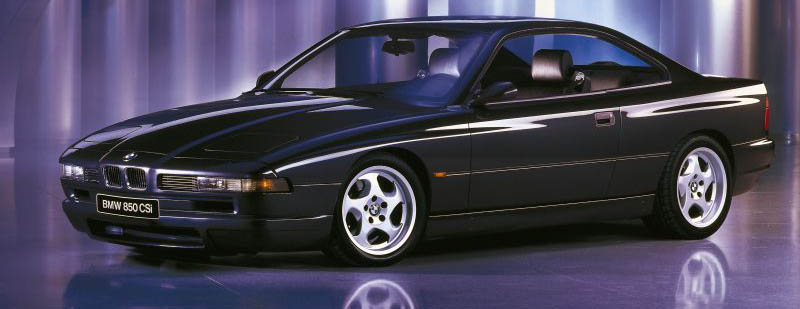
BMW 850CSi
In 1992, BMW again expanded its range and presented the particularly sporty BMW 850CSi. The V12 engine with displacement increased to 5.6 litres now generated 380 hp and assisted the coupé in achieving ultimate driving performance. Only 1,510 units were manufactured up to 1996 and the BMW 850CSi remains one of the most exclusive BMW “Youngtimers” to this day.
General Data
Model Year……………………………1992 – 1996
No. of Units…………………………..1,510
Price……………………………………DM 180,000
Technical Data
Type of Engine……………………….Twelve-cylinder V-engine
capacity in ccm………………………5576
Power Output…………………………280 kW/380 bhp at 5300 rpm
Max.Speed…………………………….250 km/h (155 mph)
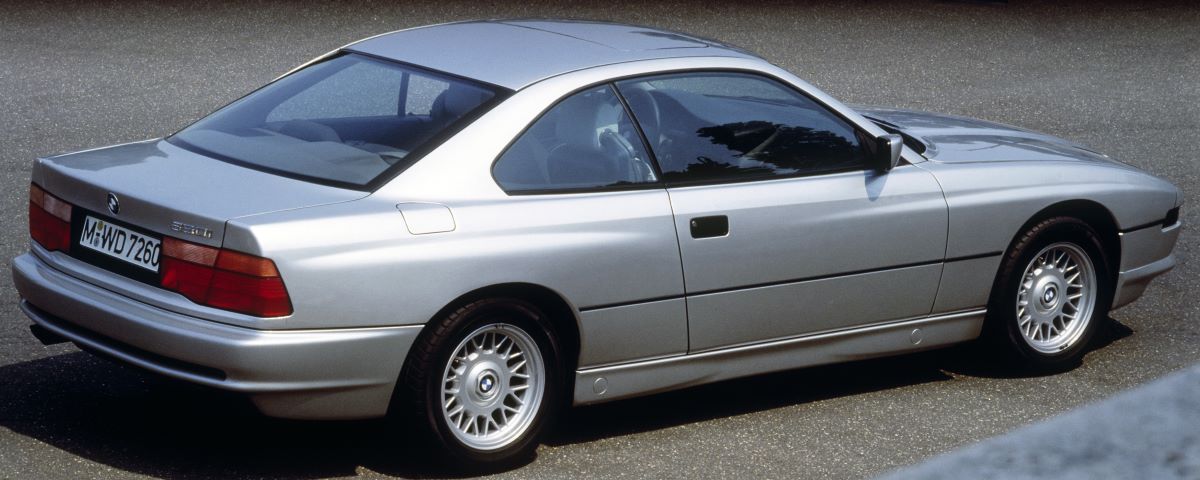
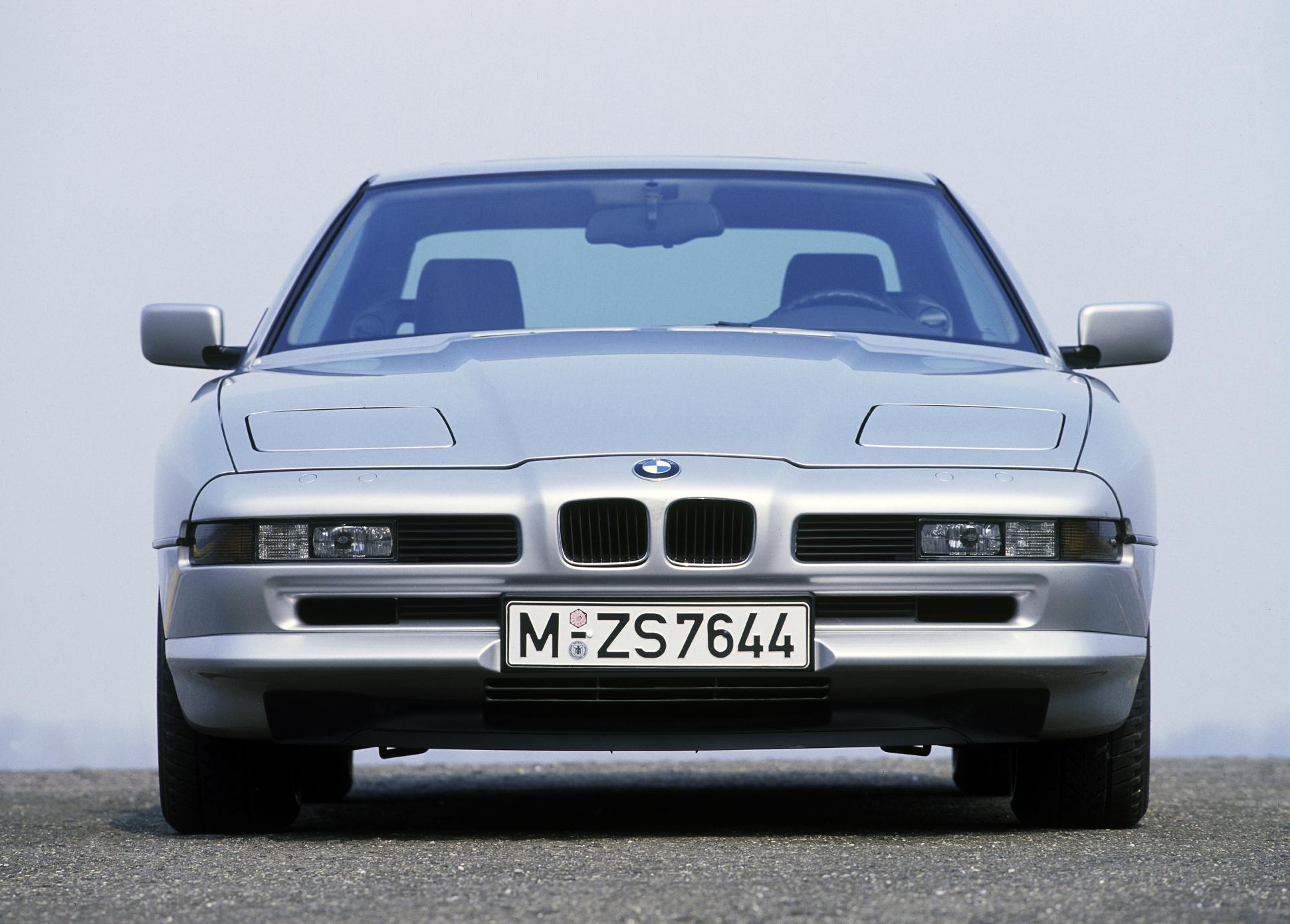
25 YEARS OF THE BMW 8 SERIES
Jun 3, 2014, Munich. It was streets ahead of its time at launch and maintains an ageless glow to this day, yet a glance at the calendar reveals the disarming truth: 25 years have passed since the BMW 8 Series was presented to the world at large for the first time. The car’s international fan community duly came together last weekend at its Bavarian birthplace to celebrate the anniversary, with events including a spectacular parade of 120 cars at the BMW Group headquarters highlighting their collective adoration of the brand’s exclusive luxury Coupe.
The event was a team effort fronted by the BMW 8 Series club 8er.org (The international 8 Series community) and ClubE31 Worldwide Owners Group e.V. with support from the BMW Club International Office. The 260 participants from 20 countries began proceedings with a tour of BMW Plant Dingolfing, where the BMW 8 Series was produced from 1989 through to 1999. The second highlight of the weekend was the gathering of club members and their cars at the BMW Museum and BMW “four-cylinder” head office in Munich for a combined photo shoot. The BMW 8 Series models fanned out in formation according to paintwork shade, creating an imposing image – and an added attraction for visitors to the BMW Museum and adjacent BMW Welt.
ClubE31 Worldwide Owners Group e.V. brings together more than 2,000 owners and fans of the BMW 8 Series from around the world. The club’s activities include regular national and international meetings and a lively experience-sharing forum. Here, members can find assistance in procuring replacement parts and expertise to help them with the upkeep and care of their cars. The meeting in Dingolfing and Munich attracted enthusiasts from the USA, Iceland and New Zealand, among other countries. Two club representations from Spain, meanwhile, decided to take their cars on a particularly epic journey to celebrate the BMW 8 Series anniversary, driving them more than 1,800 kilometres (approx. 1,120 miles) and almost 2,500 kilometres (1,550 miles) respectively to Bavaria for the event.
The BMW 8 Series stands out as a landmark model in a BMW Coupe lineage that dates back to the 1930s. A clean-sheet design, the car tagged “E31” by its maker launched its challenge to the world’s finest sports coupes with a design oozing avant-garde elegance, arresting performance attributes, an exceptional wealth of innovations and a sprinkling of exclusive luxury. The BMW 850i presented at the 1989 International Motor Show in Frankfurt represented a demonstration of the Munich-based carmaker’s development expertise, revealing not only a cutting-edge new design line but also an unparalleled array of technological details making their automotive debuts. The design of the wedge-shaped body – headlined most strikingly by a long, swooping bonnet (housing retractable headlights), smooth lines, the absence of B-pillars and a steeply cut rear end – showcased the dynamics and grace of the new coupe with equal élan.
The BMW 850i, moreover, followed the BMW 750i luxury Sedan introduced two years earlier as the second post-war German car to be powered by a 12-cylinder engine. The 5.0-litre unit developed 220 kW/300 hp and peak torque of 450 Newton metres (332 lb-ft) to propel the 1,790 kg 2+2-seater from 0 to 100 km/h (62 mph) in 6.8 seconds.
Channelling the engine’s power to the rear wheels was either a six-speed manual gearbox specially developed for the BMW 850i or a four-speed automatic, while its pioneering integral rear axle with five-link suspension was celebrating its premiere in the luxury Coupe. Automatic Stability Control plus Traction (ASC+T), speed-sensitive power steering and the Electronic Damper Control (EDC) system introduced as an option in spring 1990 were among the other details that helped give the BMW 8 Series its distinctive identity as a driving machine. The motoring press heralded the BMW 850i as a “coupe of velvet and silk” and the “perfect symbiosis of power and comfort”. After its first road test in the car, German car magazine “auto, motor und sport” wrote: “BMW has given the 850i all the high-tech weaponry it needs to take top spot.” And turning its attentions to the chassis technology of the BMW 8 Series, “Auto Bild” magazine commented: “It needs to be experienced to be believed, preferably through high-speed corners on the motorway: bumps, expansion joints – shocks that are sure to trigger sudden jolts of adrenaline in other cars – leave the 850i driver totally unruffled.”
Among the other new features of the BMW 8 Series were the belt system integrated into the seats, an electrically adjustable steering column with memory function, an automatically dimming rear-view mirror, remote-control central locking and a high-performance onboard computer. A multiplex electrical system featured for the first time, with data transfer from several different systems via the same conduit enhancing reliability and reducing weight. Both the front and rear side windows of the luxury Coupe could be fully retracted. And, in another new addition, the front side windows were automatically lowered or raised when the doors were opened or closed, improving sealing and reducing wind noise as a result.
A second version of the 12-cylinder engine was added to the range for model year 1993. With displacement increased to 5.6 litres, the engine imbued the flagship BMW 850 CSi model with 280 kW/381 hp and peak torque of 550 Newton metres (406 lb-ft). The sprint from 0 to 100 km/h (62 mph) could now be wrapped up in under six seconds. To take into account those elevated performance figures the BMW 850 CSi was also given a new driving dynamics system, including active rear axle kinematics. Here, the rear wheels respond to the car’s speed and steering angle by turning in the same direction to optimise directional stability through dynamically taken corners and sudden evasive manoeuvres. The electrohydraulic system in the BMW 8 Series was the precursor to the Integral Active Steering available for today’s BMW 7 Series, BMW 6 Series and BMW 5 Series.
With the launch of the BMW 850 CSi, the existing model was rechristened BMW 850 Ci and given myriad detail modifications. Standard equipment now included an airbag each for the driver and front passenger, infrared remote control and folding rear seat backrests. DSC (Dynamic Stability Control) was available as an option and the automatic gearbox was now equipped with adaptive control. Autumn 1994 witnessed a changing of the guard under the bonnet: the BMW 850 Ci was now powered by a 5.4-litre V12 engine with 240 kW/326 hp, which customers could choose to combine with a new five-speed automatic gearbox. The BMW 840 Ci joined the line-up in 1993. Its 4.0-litre V8 produced 210 kW/286 hp, providing an undeniably sporty entry point into the world of BMW luxury Coupes.
In 1995 the BMW 8 Series inspired British artist David Hockney to add his vision to the BMW Art Cars series. The BMW 850 CSi he created symbolised an artistic take on transparency. Hockney added flourishes such as stylised intake manifolds on the bonnet and silhouettes of the driver and steering column on the driver’s door, while the artist’s dachshund Stanley is painted onto the rear side panel as if he were a passenger in the rear.
A total of 30,621 examples of the BMW 8 Series were produced up to 1999, 24 of which were lavishly hand-built at BMW’s Rosslyn plant in South Africa. For tax reasons, assembling the cars there was more cost-efficient than importing the finished articles. More than two thirds of all the BMW 8 Series Coupes produced were 12-cylinder models, and only one in six were fitted with the six-speed manual gearbox. The top-of-the-line BMW 850 CSi accounted for 1,510 of the overall unit figure. The ultra-high-performance model was available exclusively with a manual gearbox, in keeping with its sporting character.
The tour of the Dingolfing plant also allowed the enthusiasts at the BMW 8 Series meeting to catch up with a spectacular prototype of the luxury Coupe. This one-off, high-performance variant of the BMW 8 Series was completed in 1991 and featured an all-new 12-cylinder engine developing around 550 hp, chassis technology tuned precisely to the power unit and specific body features with optimised airflow characteristics and aerodynamics. Co-developed by BMW Motorsport GmbH and BMW Technik GmbH, this super-sports car was employed as a test bed for technology and innovations. Its engine, for example, served as the basis for the V12 unit powering the legendary McLaren F1.

You must be logged in to post a comment.